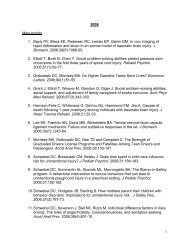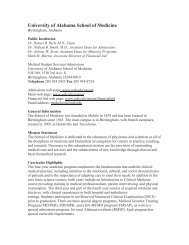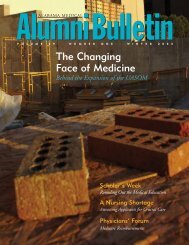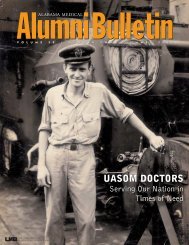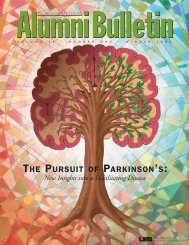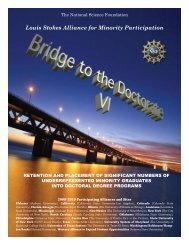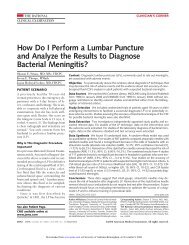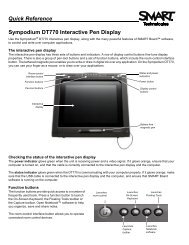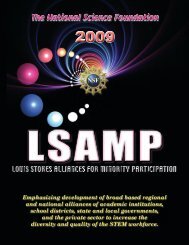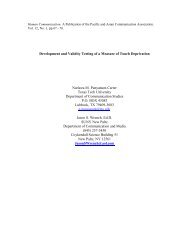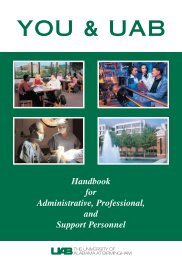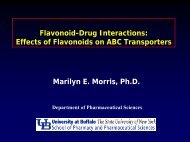AnnuAl RepoRt - University of Alabama at Birmingham
AnnuAl RepoRt - University of Alabama at Birmingham
AnnuAl RepoRt - University of Alabama at Birmingham
Create successful ePaper yourself
Turn your PDF publications into a flip-book with our unique Google optimized e-Paper software.
In 2008 there were an estim<strong>at</strong>ed<br />
10,111,000 vehicles involved in<br />
police-reported crashes,<br />
94 % (9,538,000) <strong>of</strong> which were<br />
passenger vehicles. (NHTSA)<br />
D1 - Project 2:<br />
Characterize EMS Providers’ Perspectives<br />
and Experiences with Congestion<br />
In addition to primary prevention, the issue <strong>of</strong> congestion<br />
and EMS can also be viewed from a secondary prevention<br />
perspective; th<strong>at</strong> is, identifying early opportunities<br />
for interventions to minimize congestion from impacting<br />
p<strong>at</strong>ient outcomes. In contrast to primary prevention,<br />
which in the present case would be focused on preventing<br />
congestion-rel<strong>at</strong>ed delays, secondary prevention assumes<br />
such delays will occur yet <strong>at</strong>tempts to minimize their<br />
impact. To accomplish this task, so as to fully understand<br />
the impact <strong>of</strong> congestion on EMS, it is first necessary to<br />
understand EMS providers experience with it. Thus, a<br />
survey <strong>of</strong> EMS providers’ pr<strong>of</strong>essional experience with<br />
congestion in terms <strong>of</strong> educ<strong>at</strong>ion / training, knowledge<br />
regarding role <strong>of</strong> congestion on p<strong>at</strong>ient outcomes,<br />
congestion-rel<strong>at</strong>ed driving behaviors, congestion-rel<strong>at</strong>ed<br />
decision making is being conducted. This will provide<br />
valuable inform<strong>at</strong>ion on the actual role <strong>of</strong> congestion on<br />
EMS provider behavior.<br />
D1 - Project 3:<br />
The Role <strong>of</strong> Within-Vehicle Technology<br />
for Improving EMS Response Time<br />
Another valuable secondary prevention initi<strong>at</strong>ive<br />
addressed by the study seeks to minimize the impact <strong>of</strong><br />
congestion by evalu<strong>at</strong>ing a str<strong>at</strong>egy to reduce the amount<br />
<strong>of</strong> time occupants <strong>of</strong> motor vehicle collisions (MVCs)<br />
must wait for the arrival <strong>of</strong> EMS. By providing EMS care<br />
in a more timely and informed manner, the potential impact<br />
<strong>of</strong> congestion may be mitig<strong>at</strong>ed. With respect to the<br />
str<strong>at</strong>egy <strong>of</strong> interest, autom<strong>at</strong>ic collision notific<strong>at</strong>ion (ACN)<br />
systems utilize collision sensors and wireless technology<br />
to detect and transmit inform<strong>at</strong>ion regarding the occurrence<br />
<strong>of</strong> a MVC. ACN systems represent a unique opportunity<br />
to potentially extend the Golden Hour by reducing<br />
the time between MVC occurrence and EMS arrival.<br />
While deb<strong>at</strong>e exists regarding the associ<strong>at</strong>ion between<br />
pre-hospital times and subsequent survival, more rapid<br />
EMS arrival reduces time to definitive care and such care<br />
has been shown to reduce mortality. This on-going study<br />
evalu<strong>at</strong>es whether the integr<strong>at</strong>ion <strong>of</strong> OnStar ® technology<br />
into pre-hospital care systems may yield <strong>of</strong> time savings<br />
th<strong>at</strong> (theoretically) improve p<strong>at</strong>ient outcomes. Evidence<br />
to support the integr<strong>at</strong>ion <strong>of</strong> ACN technology into EMS<br />
/ transport<strong>at</strong>ion systems may speed the provision <strong>of</strong> care<br />
and subsequent p<strong>at</strong>ient outcomes.<br />
D1 - Project 4: Potential Improvements<br />
in Medical Tre<strong>at</strong>ment and EMS through<br />
Real-time Injury Assessment <strong>of</strong><br />
Occupants Involved in Crashes<br />
(Post- Crash Injury Predic<strong>at</strong>ion using Multi-body Modeling<br />
and Advanced Region-Specific Regression Equ<strong>at</strong>ions)<br />
While secondary prevention is interested in the early<br />
detection <strong>of</strong> public health problems, tertiary prevention<br />
focuses on reducing longer term impacts. With respect<br />
to congestion and EMS, research suggests th<strong>at</strong> rapid<br />
transport times m<strong>at</strong>ter for moder<strong>at</strong>e- and high-risk p<strong>at</strong>ients.<br />
Thus, pre-transport inform<strong>at</strong>ion regarding injury<br />
severity may serve to help tailor pre-hospital / hospital<br />
care resources which may result in a more informed EMS<br />
response thereby improving p<strong>at</strong>ient outcomes. To address<br />
this need, the fourth project <strong>of</strong> the study is building upon<br />
upon existing post-crash injury assessment techniques by<br />
using AACN-rel<strong>at</strong>ed occupant, collision, and vehicle inform<strong>at</strong>ion<br />
coupled with advanced regression analysis and<br />
multi-body modeling to estim<strong>at</strong>e the regional and overall<br />
injury likelihood for MVC victims. The results <strong>of</strong> this<br />
research can be used to aid EMS personnel in the making<br />
the following decisions regarding the identific<strong>at</strong>ion <strong>of</strong>:<br />
the most appropri<strong>at</strong>e EMS unit(s) required to respond to<br />
specific MVC events (basic versus advanced life support);<br />
the most appropri<strong>at</strong>e mode <strong>of</strong> transport<strong>at</strong>ion (e.g., ground<br />
versus air ambulance); the most appropri<strong>at</strong>e medical facility<br />
(closest hospital or regional trauma center); and the<br />
most appropri<strong>at</strong>e group <strong>of</strong> specialized medical/surgical<br />
pr<strong>of</strong>essionals (neurosurgeons, orthopedists, etc.) needed.<br />
The final component <strong>of</strong> this effort will be to transl<strong>at</strong>e the<br />
findings <strong>of</strong> the research tasks into practical congestion<br />
mitig<strong>at</strong>ion techniques for emergency responders, disp<strong>at</strong>chers,<br />
traffic managers, and planners. It is expected the<br />
research program will reveal opportunities to address the<br />
congestion problem from several different perspectives.<br />
The end product <strong>of</strong> this task will be a set <strong>of</strong> techniques<br />
to address congestion along with practical guidelines for<br />
implement<strong>at</strong>ion coupled with cost projections and costbenefit<br />
specific<strong>at</strong>ion.<br />
This multidisciplinary, public-health approach will yield<br />
valuable inform<strong>at</strong>ion th<strong>at</strong> can be subsequently used to<br />
address the congestion problem on multiple fronts.<br />
research 21



